- Joined
- Oct 22, 2018
- Messages
- 136
- Points
- 253

The Bahia saveiros were born in Recôncavo Baiano, in the shipyards of various locations such as Massaranduba and Cabrito in Itagipe, Santo Amaro, São Roque, Cachoeira, São Félix, Ilha de Bom Jesus, Madre de Deus, São Francisco do Conde, Santo Amaro de Catu, Tubarão, Salinas da Margarida, Conceição de Salinas, Itaparica, Caboto and other places with smaller shipyards, where shipwrights conceived and built boats with similar characteristics. Although there is no unanimity regarding the origin of the saveiro, the most common opinion is that it was brought from Portugal around the 16th century by emigrated builders from the Old World, who adapted to the needs and available materials of the new Portuguese colony. On the Brazilian seacoast, with a profusion of natural ports, and with a climate that is also conducive to sailing, coastal navigation was considered a basic need. The boats they used to cross the oceans were not the most appropriate to move around the small coves and thousands of islands.
These emigrated riverside carpenters brought with them the instrument and construction technique that was common in southern Europe at the time, with the use of gauges or templates that provided the dimensions and master sections of the future vessel. In Portuguese these templates are called graminhos, in Mediterranean France gabarit de saint Josef, in Venice sesto, in Genoa garibbo, in Sicily miezzo jabbu and in northern France trabuchet...
Although in Portugal there are no ships equal to the Brazilian saveiro, it should be noted that it has aspects very similar to the Tejo varino ship and several things in common with the Fragata do Tejo and even with the Bote do Tejo, `so it can be said that its predecessor was the constructive tradition of the carpenters of the banks of the river Tagus.
The rig was made higher to adapt it to the winds of the area; As for the hull, it suffered variations in the height of the freeboard, the arrangement of the elements of the small foredeck, the rudder, etc. But important similarities remain, such as the type of rig; the shape of the stem, almost crescent; the square stern and the general dimensions that maintain practically the same proportions. Its greatest differences are found in the saveiros closed with tijupá (a kind of gabled roof-roof), those that have a cabin at the stern for crew accommodation and those that have the stern rabo de peixe,(similar to the stern of the canoes)
One of the most unique characteristics of the saveiros is that their masts are not braced, that is, they do not have any rigging to hold the masts, which are quite large, since they can reach heights of more than 20 meters and weigh more than a ton. The spars are maintained due to the construction technique, because they unfold with a pronounced slope towards the stern of the boat, supported by their own weight. In addition, the quality of the wood and its flexibility are other factors that contribute to the maintenance of the masts. According to Lev Smarcevisky, Bahian architect author of a study on saveiros "the perfect hydrodynamic shape of the hull, integrated into the frame and the sail plan, is the main conservation factor of the entire system."
Smarceviski's study is very interesting. In it he shows that the greatest danger of breaking the mast, paradoxically, occurs when the ship is at anchor and the sails are furled. In this case “even with small and rhythmic waves, the movement of the mast can enter into resonance, in an increasing sway, until breaking”.
The saveiros are exclusive vessels of the state of Bahia, and different types can be observed among them, such as:
• Saveiro with an open stern, with a gaff sail and jib, frequently presents the tijupá (the aforementioned roof in the form of a gabled roof).
• Saveiro rabo de peixe: with a sharp stern, two masts, square sail on the foresail and gaff sail on the mainsail and also equipped with tijupa.
• Saveiro whaling, a single mast and a sail reminiscent of the European third sail, with a black hull and equipped with oars.
• Saveiro perné: three masts and bowsprit, with jib and sometimes a genoa, square sail on the foresail and gaff main and mizzen sails. Used to transport people and goods between towns outside the Bay of All Saints
• Saveiro perua: three masts, the foresail with a square sail and the main one with a gaff, which are set one next to the other, and a gaff sail also on the mizzen. It is a large saveiro, equipped with a tijupa and an extension at the stern called a xapité.
• Fishing saveiro, with two masts, jib and lateen sails. Used for deep sea fishing.
With rigs like the one described, the crew members of the saveiros show and be true masterminds of the maneuver, since they guide the vessel within the same port, lowering and hoisting sails, to make it turn, all without any help, while the skipper deals with the rudder and mainsheet. Given the climatic conditions that usually occur in its waters, with the trade winds blowing very hard, some showers and fresh winds from the south, one cannot help but admire the navigation that these boats carry out, with such flexible masts and hard maneuvers that require a great skill, an idea of which is had by observing the enormous mainsail, with its sheet devoid of rigging.
The gaff sails that they carry, with loose legs and no boom, are attached to the mast by a rope and have a surface area of close to 120 square meters, being tall and narrow (3 to 4 m wide). The hull is made of wood, with lengths of 12 to 15 meters, a beam of 4 to 5 and 1.50 m. of strut. In the bow they have a small deck that is used for maneuvers. The bottom is almost flat, which allows it to run aground with minimal heeling when the tide goes out, thus allowing loading and unloading between two tides.
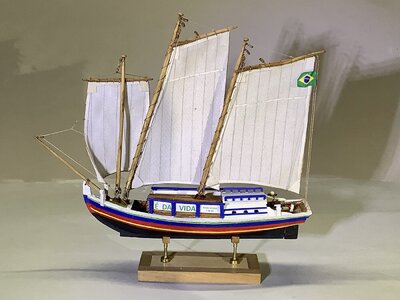
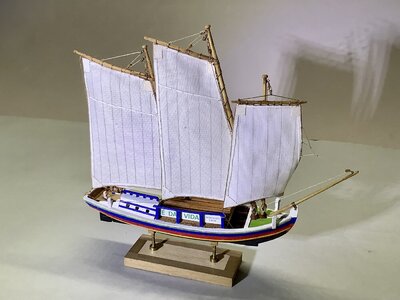
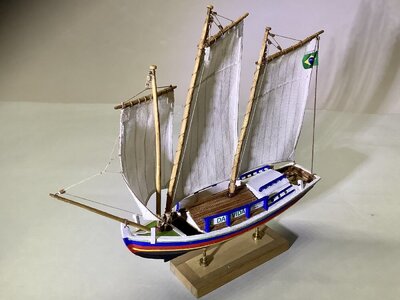
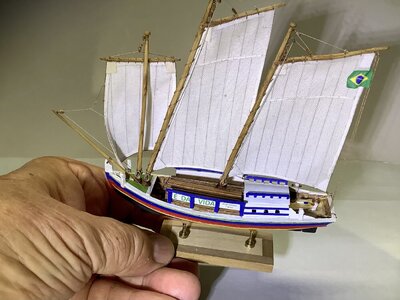
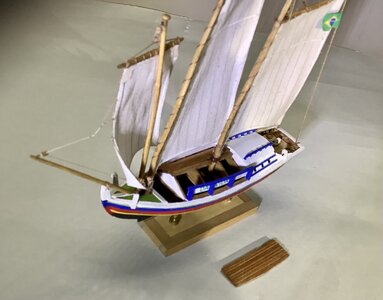
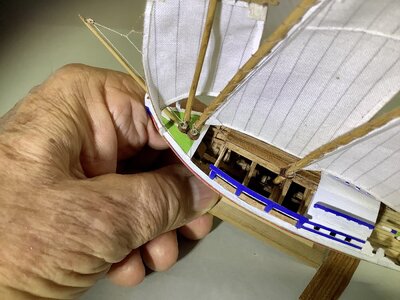
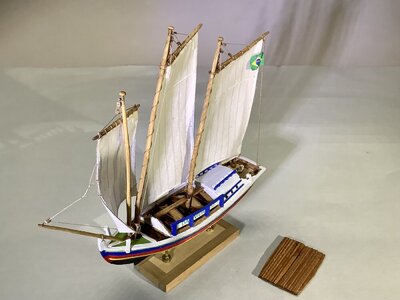
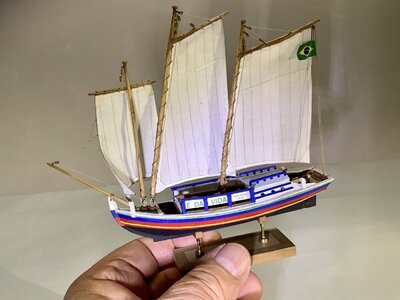
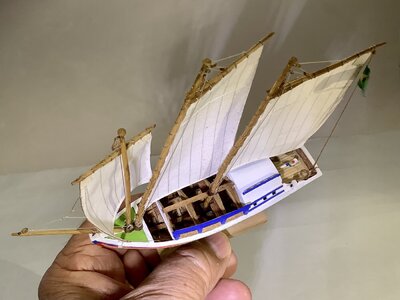
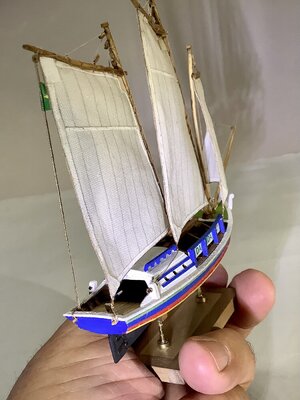
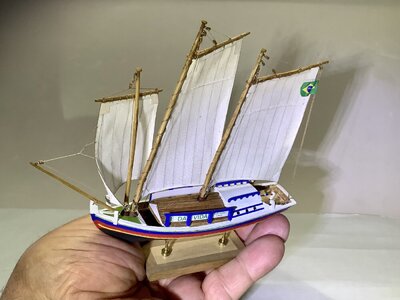
These emigrated riverside carpenters brought with them the instrument and construction technique that was common in southern Europe at the time, with the use of gauges or templates that provided the dimensions and master sections of the future vessel. In Portuguese these templates are called graminhos, in Mediterranean France gabarit de saint Josef, in Venice sesto, in Genoa garibbo, in Sicily miezzo jabbu and in northern France trabuchet...
Although in Portugal there are no ships equal to the Brazilian saveiro, it should be noted that it has aspects very similar to the Tejo varino ship and several things in common with the Fragata do Tejo and even with the Bote do Tejo, `so it can be said that its predecessor was the constructive tradition of the carpenters of the banks of the river Tagus.
The rig was made higher to adapt it to the winds of the area; As for the hull, it suffered variations in the height of the freeboard, the arrangement of the elements of the small foredeck, the rudder, etc. But important similarities remain, such as the type of rig; the shape of the stem, almost crescent; the square stern and the general dimensions that maintain practically the same proportions. Its greatest differences are found in the saveiros closed with tijupá (a kind of gabled roof-roof), those that have a cabin at the stern for crew accommodation and those that have the stern rabo de peixe,(similar to the stern of the canoes)
One of the most unique characteristics of the saveiros is that their masts are not braced, that is, they do not have any rigging to hold the masts, which are quite large, since they can reach heights of more than 20 meters and weigh more than a ton. The spars are maintained due to the construction technique, because they unfold with a pronounced slope towards the stern of the boat, supported by their own weight. In addition, the quality of the wood and its flexibility are other factors that contribute to the maintenance of the masts. According to Lev Smarcevisky, Bahian architect author of a study on saveiros "the perfect hydrodynamic shape of the hull, integrated into the frame and the sail plan, is the main conservation factor of the entire system."
Smarceviski's study is very interesting. In it he shows that the greatest danger of breaking the mast, paradoxically, occurs when the ship is at anchor and the sails are furled. In this case “even with small and rhythmic waves, the movement of the mast can enter into resonance, in an increasing sway, until breaking”.
The saveiros are exclusive vessels of the state of Bahia, and different types can be observed among them, such as:
• Saveiro with an open stern, with a gaff sail and jib, frequently presents the tijupá (the aforementioned roof in the form of a gabled roof).
• Saveiro rabo de peixe: with a sharp stern, two masts, square sail on the foresail and gaff sail on the mainsail and also equipped with tijupa.
• Saveiro whaling, a single mast and a sail reminiscent of the European third sail, with a black hull and equipped with oars.
• Saveiro perné: three masts and bowsprit, with jib and sometimes a genoa, square sail on the foresail and gaff main and mizzen sails. Used to transport people and goods between towns outside the Bay of All Saints
• Saveiro perua: three masts, the foresail with a square sail and the main one with a gaff, which are set one next to the other, and a gaff sail also on the mizzen. It is a large saveiro, equipped with a tijupa and an extension at the stern called a xapité.
• Fishing saveiro, with two masts, jib and lateen sails. Used for deep sea fishing.
With rigs like the one described, the crew members of the saveiros show and be true masterminds of the maneuver, since they guide the vessel within the same port, lowering and hoisting sails, to make it turn, all without any help, while the skipper deals with the rudder and mainsheet. Given the climatic conditions that usually occur in its waters, with the trade winds blowing very hard, some showers and fresh winds from the south, one cannot help but admire the navigation that these boats carry out, with such flexible masts and hard maneuvers that require a great skill, an idea of which is had by observing the enormous mainsail, with its sheet devoid of rigging.
The gaff sails that they carry, with loose legs and no boom, are attached to the mast by a rope and have a surface area of close to 120 square meters, being tall and narrow (3 to 4 m wide). The hull is made of wood, with lengths of 12 to 15 meters, a beam of 4 to 5 and 1.50 m. of strut. In the bow they have a small deck that is used for maneuvers. The bottom is almost flat, which allows it to run aground with minimal heeling when the tide goes out, thus allowing loading and unloading between two tides.















